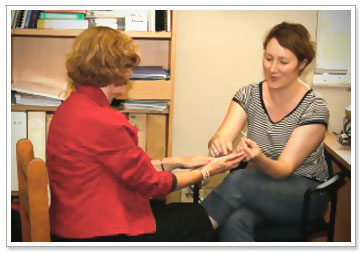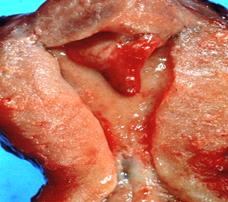Hannah is a 40 year old woman who presents at your clinic because of her heavy periods. She has 3 children- the youngest is 8 years old. She had regular 5 to 6 day periods up until 2 years ago when they started to get longer and heavier. Now she bleeds for about 9 to 10 days with clots and often has to wear pads along with tampons. She changes these 3-4 times a day and has to get up at night. She has just finished her period this month and feels exhausted. This has prompted her to make the appointment today. Before you see her you've had a quick look at her previous visit which was 3 years ago for her smear (always normal) and for a further supply of condoms. She has generally been fit and BP was normal. She is 75 kg, a non smoker and has no family history of note.
 Activities A-D
Activities A-D
A. Which of the following are risk factors for endometrial cancer ?
4. Contraceptive pill use?
B. You now want to take a more detailed history of Hannah's periods. What particular abnormal bleeding patterns will you ask about that may be associated with cervical or endometrial malignancy? Have a think about this yourself before you view our answer.

Click here to view the answer
Intermenstrual and postcoital bleeding- Intermenstrual and postcoital bleeding can be common in women using hormonal contraceptives. In primary care these symptoms can be investigated by visualising the cervix, taking a cervical smear if there is not a recent result and sexually transmitted infection (STI) swabs to rule out infection. The NICE guidelines recommend that an endometrial sample should be taken if intermenstrual bleeding is persistent in a woman over 45 years (see pg 63). Many primary practitioners have now had training using Pipelle biopsy. Specialist referral is needed if the cervix appears abnormal, abnormal cytology or histology results, or continuation of postcoital bleeding or intermenstrual bleeding after normal smear or endometrial sample.
Intermenstrual and postcoital bleeding- Intermenstrual and postcoital bleeding can be common in women using hormonal contraceptives. In primary care these symptoms can be investigated by visualising the cervix, taking a cervical smear if there is not a recent result and sexually transmitted infection (STI) swabs to rule out infection. The NICE guidelines recommend that an endometrial sample should be taken if intermenstrual bleeding is persistent in a woman over 45 years (see pg 63). Many primary practitioners have now had training using Pipelle biopsy. Specialist referral is needed if the cervix appears abnormal, abnormal cytology or histology results, or continuation of postcoital bleeding or intermenstrual bleeding after normal smear or endometrial sample.
C . Now you need to start thinking of the issues that you will want to discuss with Hannah at this visit. List at least 6 of these
Check below for our thoughts.
1. Impact of periods on lifestyle?
2. Likely causes of her heavy menstrual bleeding (HMB)
3. Plan for more children?
4. Happy with the contraceptive method?
5. Investigations/examinations you would like to do
6. Treatments that are likely to help
1. Impact of periods on lifestyle?
2. Likely causes of her heavy menstrual bleeding (HMB)
3. Plan for more children?
4. Happy with the contraceptive method?
5. Investigations/examinations you would like to do
6. Treatments that are likely to help
D. It becomes clear as you talk to Hannah that her periods are really getting her down -she has no energy and can't understand why she has put off doing something about it till now-she would like some advice. Although it is likely that her HMB is not associated with pathology ie is dysfunctional uterine bleeding (DUB) there are other causes which you need to think about.
Which of the following are associated with HMB:
4. Inherited blood disorders ?

 Case Study 1 - Hannah
Case Study 1 - Hannah Activities A-D
Activities A-D for a diagram of a fibroid uterus.
for a diagram of a fibroid uterus.  for a picture of an endometrial polyp
for a picture of an endometrial polyp 


